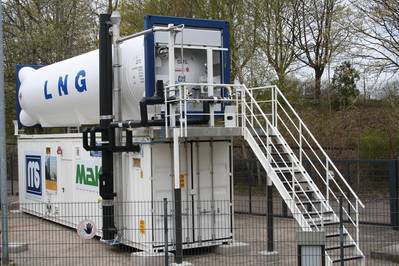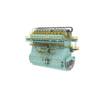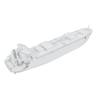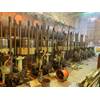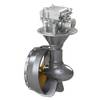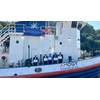With eyes on the future of liquefied natural gas (LNG) in the maritime sector, Caterpillar Marine said it will unveil a first-of-its-kind LNG test bed for gas-fuelled engines at its facility in Kiel, Germany where the company will aim to improve understanding of related technology and enhance its services to clients adopting LNG solutions.
According to Caterpillar, the site will focus on familiarizing its personnel with LNG capabilities, testing and improving LNG components, developing LNG plants for actual operations, demonstrating LNG benefits to clients, and facilitating customer training to not only become familiar with LNG, but also teach customers important safety information regarding LNG handling and operational procedures.
The new LNG preparation unit comprises of a LNG tank and a gas preparation unit, both in 40 ft container size, developed and provided by Marine Service GmbH, Hamburg.
Georg Gillert, engineering supervisor for Caterpillar Marine, called the test bed “a milestone in LNG development.”
“While LNG is a promising fuel, it does offer unique challenges,” Gillert added. “LNG has to be kept at extremely low temperatures to prevent it from vaporizing, and this requires additional gas handling components not found in other power systems. New engine and gas handling architecture is needed to take full advantage of LNG’s emissions benefits. Customized monitoring and control processes will also be needed to optimize full/air composition and safe engine operation.”
Caterpillar is already a player in LNG power with its MaK branded dual fuel engines capable of running on marine diesel oil (MDO) or natural gas (NG), but the company said there’s still a lot to learn about LNG and the engineering required to maximize its potential.
“LNG offers obvious benefits to marine power and it’s considered a true future fuel,” Gillert said. “It burns cleaner than other fuels, emitting low amounts of nitrogen oxide (NOx), sulfur oxides (SOx), particulate matter and carbon dioxide. When handled properly, LNG offers a clear path to regulation compliance with all current and future standards.”
LNG also provides greater energy density than natural gas in its gaseous form, and it’s possible to store up to 600 times more LNG than standard natural gas, Caterpillar noted.
LNG’s clean burning nature has drawn numerous vessel owners, and particularly those with an eye for future compliance. Several marine industries, including cruise lines and chemical/oil tanker operations, have begun fitting fleets with MaK power, and gas-fuelled engine prevalence will only increase over time, Caterpillar said.
• 

